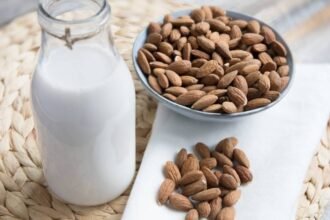Halloween is just around the corner, and you may be looking for some spooky treats to serve at your Halloween party. If you want to scare and delight your guests, bleedings black cupcakes are the perfect option.
These cupcakes look positively terrifying, with a dark chocolate cake and oozing red jam center that resembles blood. But don’t be fooled, they are as delicious as they are ghoulish.
Origins and History
Bleeding cupcakes likely originated as a Halloween take on the classic Black Forest cake. Black Forest cake has its origins in the Black Forest region of Germany and features chocolate cake layers with cherry syrup pouring out between them.
To give the cupcakes a scarier look for Halloween, red jam and food coloring are used instead of cherry syrup.
The earliest references to bleeding cupcakes seem to date back to around 2013-2014, with many food blogs and parenting sites sharing bloody cupcake recipes and photos. Their popularity has grown through food blogs and social media, with bleedings black cupcakes becoming a popular DIY Halloween treat.
Ingredients Needed
To make these gory treats at home, you’ll need the following ingredients:
For the cupcake batter:
- All-purpose flour
- Granulated sugar
- Unsweetened cocoa powder
- Baking soda
- Salt
- Vegetable or canola oil
- Full-fat sour cream
- Large eggs
- Warm water
- White vinegar
- Vanilla extract
For the bleeding jam filling:
- Seedless raspberry jam
- Corn syrup
- Red food coloring
For decorating:
- Cream cheese frosting (black if desired)
- Red food coloring
- Sprinkles (optional)
Cupcake Batter and Baking Instructions
Follow these steps to whip up a frightfully delicious chocolate cupcake batter:
- Preheat your oven to 350°F. Line a 12-cup muffin tin with paper liners.
- In a medium bowl, whisk together the flour, sugar, cocoa powder, baking soda and salt.
- In a large bowl, beat together the oil, sour cream, eggs, warm water, vinegar, and vanilla.
- Add the dry ingredients to the wet ingredients and mix just until combined.
- Divide the batter evenly among the lined muffin cups, filling each about 2/3 full.
- Bake for 18-22 minutes, until a toothpick inserted comes out clean. Allow to cool completely before frosting.
Read More: Spooky Cinnamon Rolls: The Perfect Treat for Halloween
Making the Bleeding Jam Filling
To achieve the bloody effect, you’ll need to make a jam filling to pour over the cooled cupcakes:
- In a small saucepan, combine the raspberry jam, corn syrup and red food coloring. Heat over medium, stirring frequently, until thin and pourable.
- Use a paring knife to cut a cone-shaped piece from the top center of each cooled cupcake. Remove the cut piece and set aside.
- Spoon a small amount of the jam mixture into the center of each cupcake. Don’t overfill, as the jam will expand as it warms.
- Replace the cut-out piece of cupcake on top, pressing down gently to seal. The jam will gradually leak down the sides, creating a gory effect.
Decorating the Cupcakes
To complete these Halloween treats:
- Prepare a batch of cream cheese frosting. For black frosting, mix in a small amount of black gel food coloring. Frost each cupcake.
- For added effect, drizzle a small amount of the jam filling over the top of the frosted cupcakes.
- Let the jam continue to ooze down the sides. Refrigerate until ready to serve.
- Decorate with sprinkles or serve the cupcakes in a pool of red jam for a horror-movie vibe.
Party Tips and Serving Suggestions
Bleeding black cupcakes are guaranteed to be a hit at any Halloween party or event. Here are some tips for serving:
- Display them on a black cake stand or glass serving dish for dramatic effect. Surround with Halloween decorations.
- Spear each cupcake with a mini plastic knife or sword to heighten the scary factor.
- Serve alongside other ghoulish treats like eyeball deviled eggs, mummy hot dogs, or dirt and worms dessert pudding.
- Offer blood red punch in addition to the cupcakes. Float dry ice in the punch bowl for spooky smoking effect.
- Repackage them in coffin favor boxes so guests can take the terror home.
With their creepy appearance and rich chocolate-cherry flavor, bleeding cupcakes are sure to steal the show at your Halloween party. Just be prepared for screams and delighted gasps when you unveil these gory treats!
Read More: Peanut Butter Spider Cookies: Terrifyingly Tasty Halloween Fun
Making Bleeding Black Cupcakes Kid-Friendly
While bleeding cupcakes make for a spooky Halloween treat, they may be too intense for young trick-or-treaters or school parties. Luckily, you can easily give these cupcakes a kid-friendly makeover. Here are some tips:
Use Brightly Colored Icing
Skip the gory red jam and go for a brighter, more cheerful look. After baking basic chocolate cupcakes, frost them with brightly colored icing in shades of orange, purple, or neon green. Decorate with themed sprinkles and candy corn for a festive look.
Omit the Blood and Guts
The bleeding jam and red food coloring can be frightening for little ones. For a simpler approach, fill your cupcakes with strawberry or raspberry jam. Top with regular frosting and Halloween sprinkles.
Create Friendly Monster Cupcakes
Use your favorite cupcake recipe to make chocolate or vanilla cupcakes. Frost with vanilla or cream cheese frosting. Decorate with candy to create silly monster faces. Use M&Ms for eyes, licorice for mouths, and fruit leather for tongues. Kids will get a kick out of these not-so-scary creature cupcakes.
Offer Creepy Crawler Cupcake Toppers
Gummy worms, spiders, and bugs make great kid-friendly cupcake decor. Skewer them on top of cupcakes frosted with green, brown or black icing for life-like dirt and moss effects. It’s creepy but not gory.
Make Mummy Cupcakes
Wrap unfrosted cupcakes with strips of fruit roll-ups or fruit by the foot to create mummy “bandages.” Use black or brown frosting as “mold” and add candy eyes. Adorable and not too terrifying!
Top with Spooky Creatures
Pick up Halloween themed cupcake toppers at craft stores or online. Little plastic spiders, bats, ghosts, pumpkins, and witches make any basic cupcake look festive.
Offer Healthier Alternatives
For school parties or health-conscious parents, make “blood” from pureed berries or beet juice. Use whole wheat flour and lower sugar frosting. Top with fresh fruits and nuts in fun shapes.
While the gory versions may be best reserved for adult events, bleeding cupcakes can easily get a kid-approved makeover. Let their creativity run wild to come up with their own spooky (but not too spooky) decorating ideas. Getting to customize their Halloween treats makes the holiday even more fun.
Read More: How to Make a Frightfully Delicious 3-Course Halloween Dinner
A Brief History of Cupcakes
Cupcakes have become a beloved treat for parties, special occasions, and even casual snacks. But where did these handheld cakes originate? Let’s take a brief look at the history of the cupcake.
18th Century: Early Inspiration
The earliest recognizable cupcakes emerged during the late 18th century. At this time, hearth cakes were popular. These were simple cakes baked individually in ceramic cups near the dying embers of a fire. The cupcake concept likely grew out of these primitive hearth cakes.
19th Century: Cupcake Innovation
By the mid-1800s, hearth cakes had evolved into more modern cupcake forms. In the 1896 edition of the Boston Cooking-School Cook Book, two cupcake recipes are listed. One is for a crusty cup custard baked in ramekins. The other is more like contemporary cupcakes, leavened with baking powder and using currants for texture.
Early 20th Century: Rise of Bakeries
The early 20th century saw a boom in bakeries, many of which began offering individual-sized cakes. These were sometimes called fairy cakes or number cakes, numbered based on size. The earliest known printed use of the exact term “cupcake” was in 1922. As kitchen appliances like electric mixers became more common, home bakers could more easily make cupcakes themselves.
Post War Era: American Classic
Following World War II, cupcakes really took off as an American classic. Hostess introduced its iconic snack cakes, like Twinkies, in the 1930s-1950s. Convenient packaged treats fit the modern lifestyle. The 1950 Good Housekeeping cookbook formally codified the differences between cupcakes, muffins, and cake.
21st Century: Gourmet Revival
By the 1990s, cupcakes became more gourmet and creative. Bakeries like Magnolia in New York helped launch the upscale cupcake trend. TV shows like Sex and the City and colorful cookbooks sent cupcake popularity soaring. The cupcake craze led to community cupcake shops, bake-offs, even cupcake-only retailers.
Today: Quintessential Crowd-Pleaser
Now firmly established as a quintessential American treat, cupcakes continue to evolve. Baker continue innovating with new flavors, fillings, frostings and decorations. Their creativity, customization, and portion-control makes cupcakes perfect for parties, gifting, and simple snacking. Hundreds of years later, these hand-held cakes still bring joy with every bite.
Cupcake Baking Tips and Tricks
For beginner bakers making cupcakes for the first time, the process can seem daunting. Here are some handy tips and tricks for cupcake success:
Use Room Temperature Ingredients
- Allow eggs, butter, and milk to come to room temperature before mixing – this helps achieve a light and fluffy texture. Cold ingredients can make batter dense.
Avoid Overmixing the Batter
- Gentle folding is key for tender, even-textured cupcakes. Overbeating can cause gluten development, leading to toughness.
Fill Liners 2/3 Full
- Underfilled cups won’t rise properly in the oven. Overfilled batter can spill over liners and stick to the pan. About 2/3 full is ideal.
Stagger Bake Times
- Fill one muffin tin first, then the second. This prevents the first batch from overbaking while you fill the second pan.
Test Center and Edge for Doneness
- Cupcakes bake unevenly. Test both the center and outer edge with a toothpick before removing from oven.
Cool Completely Before Frosting
- Decorating warm cupcakes causes the frosting to melt and slide right off. Let cool 15-20 minutes before frosting for best results.
Seal In Freshness
- Once cooled and frosted, store cupcakes in an airtight container at room temperature up to 2 days. Refrigeration can ruin frosting textures.
Transport Carefully
- Line a rigid container with parchment to prevent sliding and frosting smudges when transporting finished cupcakes.
With the right ingredients, tools, and techniques, you’ll be whipping up perfect bakery-style cupcakes in no time. So preheat that oven and get baking – a delicious batch of cupcakes awaits!




